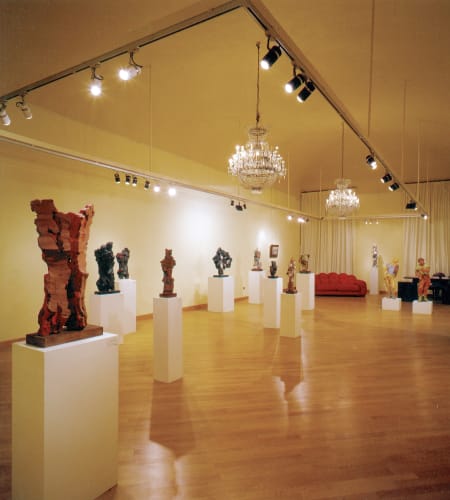«The impulse to take a stick and violently cut the clay with it, the impulse to gently shake its surface with the palm of the hand to make it throb in the light or, with it, to flatten it into a rough and arid expanse. These impulses arise from deep feelings, they accompany me under my consciousness, they resurface in sharp strokes [...] it is the feeling that become image, but the image is born from itself not from a "mirrored object"». (Leoncillo Leonardi, Piccolo Diario, 1957 in AA. VV. Leoncillo, G.A.M. Edizioni Maggiore, Bologna 2002)
These are the words with which Leoncillo describes in a page of his diary the impulse that nourishes his creative practice. Words that today let the readers participate in the deep psychic and emotional rigour that feeds Leoncillo's art. A multifaceted series of evocations and feelings that can be retraced in the rooms of the Galleria d'Arte Maggiore g.a.m. which hosts, for this occasion, an accurate selection of sculptures and works on paper that illustrate Leoncillo's artistic activity from 1938 until the second half of the 1960s.
Born in Spoleto in 1915, Leoncillo's artistic career has already started to achieve success from the Forties,when he takes part to the VII Triennale in Milan, invited by Gio Ponti, and when, in 1947, he signed the manifesto of the Nuova Secessione Artistica Italiana (New Italian Artistic Secession), then turned into Fronte Nuovo delle Arti. This was a movement known for the interest in the modernity that was running throughout Italy in the post-war period, and the openness to a dialogue with European styles. Alberto Moravia is the first to notice the "complicate and singular" neocubist-inspired art of Leoncillo, during the first exhibition of the Fronte. From 1948 the artist is soon protagonist of six editions of the Venice Biennale, but the most memorable of these is the one in 1954, during which an entire exhibition room is dedicated to him and Lucio Fontana. Two years later, in 1956, Leoncillo is commissioned to realize the Monumento ai Caduti di tutte le guerre (Monument to the Fallen of all wars) in Albissola Marina, a silent testament composed by statues, wandering around like ghosts on an empty basement. Galleria d'Arte Maggiore g.a.m. displays in this exhibition a fine study for this monument. In these years Leoncillo is experiencing a period of existential, ideological and artistic crisis, a crisis that turns out to be a fundamental turning point for his maturation, causing his abandonment of the post-cubism and his approach to the informal language, and inspiring the creation of works that recall emotion and sense of nature: "If it is true that figuration is no longer useful either to us or to others then let's throw away this substitute of "form" as well. I really have no desire to bow down to this god. [...] And so what I want, what I have to do will be born as a new natural object, like a plant that makes leaves. Leaves that "if we didn't already know them" would have an unexpected shape. A new natural object that is profoundly true to our naturalness, like a stone that is of the earth, like the leaf of the tree, like this hand that is mine. A new natural object that becomes with stratifications, furrows, tears that are those of our being, that comes out like our breath". (Leoncillo Leonardi, Piccolo Diario, 1957 in AA. VV. Leoncillo, G.A.M. Edizioni Maggiore, Bologna 2002)
Sculptures like Taglio rosso (Red cut) from 1963, suspended between metaphor and memory, together with the selection of works on paper here exhibited, show how the artist has been able to find in this language the perfect tool to express the deep and constant conflict that move his soul, and to reach international success in the early Sixties with exhibitions in Paris, New York, Lubiana, Naples and Montreal.
